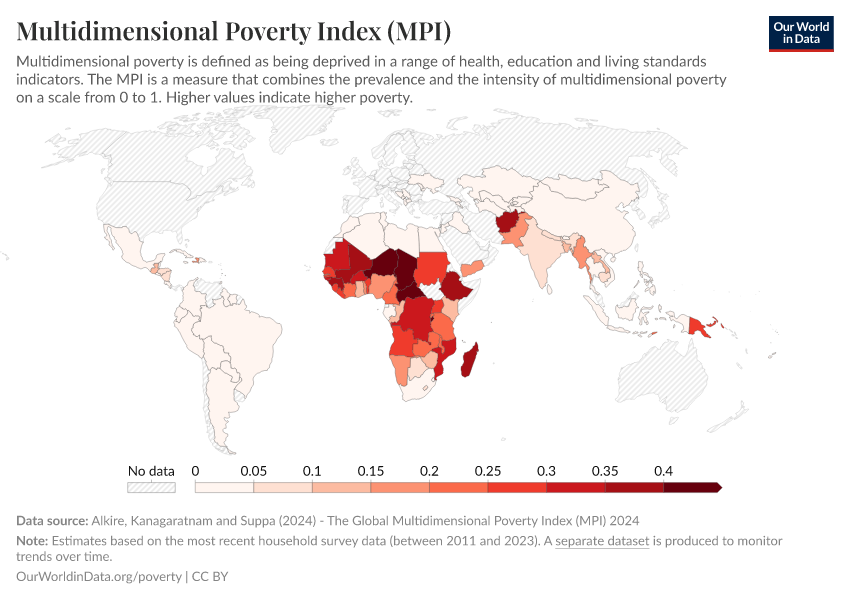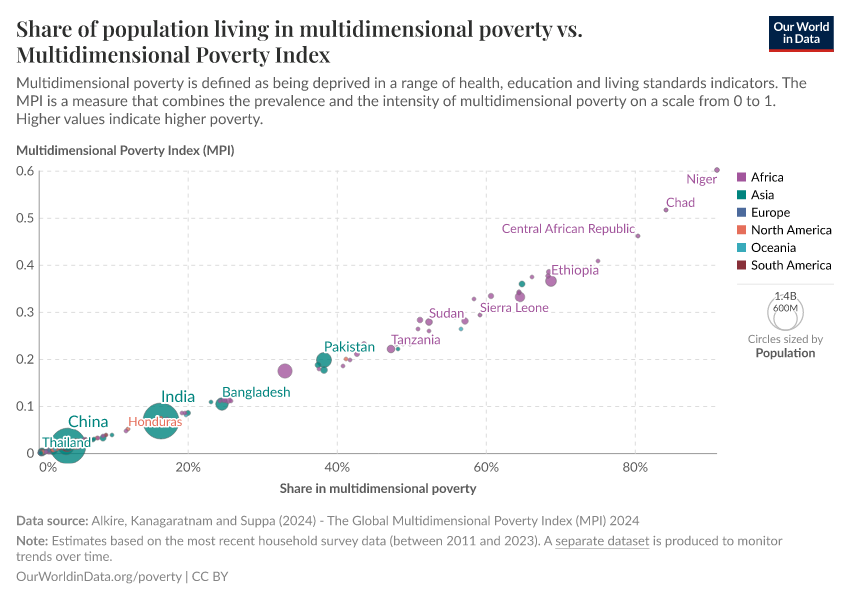Multidimensional Poverty Index (MPI)

What you should know about this indicator
- The Multidimensional Poverty Index (MPI) is calculated by multiplying two values: the share of people who are multidimensionally poor and the intensity of their poverty.
- Being in multidimensional poverty means that a person lives in a household deprived in a third or more of ten indicators, grouped into three dimensions of well-being: health (using two indicators: nutrition, child mortality), education (using two indicators: years of schooling, school attendance), and living standards (using six indicators: cooking fuel, sanitation, drinking water, electricity, housing, assets).
- Each household is assessed against specific thresholds for these indicators. For example, a household is considered deprived in the electricity indicator if it does not have access to it. This article discusses specific thresholds in more detail.
- Each indicator contributes to one of the three dimensions of well-being. Health and education indicators are weighted more (1/6 each) than living standards indicators (1/18 each) so that all three dimensions contribute equally to the overall measure.
- The intensity of multidimensional poverty is calculated as the average share of indicators in which those counted as MPI poor are deprived.
- This indicator is a current margin estimate (CME), meaning that it relies on the most recent survey data available for each country. Look for the harmonized over time (HOT) estimate to see trends over time.
Related research and writing
Frequently Asked Questions
How is multidimensional poverty defined in the MPI?
Multidimensional poverty refers to a way of understanding and measuring poverty that goes beyond income or consumption levels. It captures the many ways in which people experience deprivation.
The Oxford Poverty and Human Development Initiative (OPHI) defines multidimensional poverty through the Multidimensional Poverty Index (MPI). The MPI uses 10 indicators grouped into three dimensions: health, education, and living standards. A person is considered to be living in multidimensional poverty (MPI poor) if they are deprived in at least one-third of these weighted indicators.
The indicators are not equally weighted. “Health” and “education” indicators each contribute 1/6 to the total, while “living standards” indicators contribute 1/18 each. This ensures the three dimensions are equally represented in the overall measure.
Which sources does OPHI use to produce global estimates of multidimensional poverty?
OPHI calculates the Multidimensional Poverty Index (MPI) using data from large-scale household surveys, primarily the Demographic and Health Survey (DHS), the Multiple Indicators Cluster Survey (MICS), and other national surveys when recent data from these two sources is not available.
These surveys include detailed information about households, covering questions about nutrition, school attendance, sanitation, and access to clean drinking water. Each household is assessed against specific deprivation thresholds for all 10 indicators. If a household falls short in a third or more of the weighted indicators, it is classified as multidimensionally poor, and all its members are also considered poor.
What if not all indicators are available for a country?
Not all countries have recent and comparable data for all ten indicators. When data for some indicators is missing from the survey data, those indicators are excluded from the calculation of the MPI, and the weights of remaining indicators are proportionally adjusted to maintain equal weights across the three dimensions (health, education, living standards).
MPI estimates are only calculated for a country where:
- at least one “health” and one “education” indicator is available
- at least four indicators in “living standards” are available
How comparable is the MPI data across time or between countries?
MPI data can be compared by using harmonized indicators across countries and time. However, challenges arise due to variations in survey designs, timing, and indicator availability.
For international comparisons using the latest available survey data, OPHI provides current margin estimates (CME), which apply consistent definitions and thresholds across all countries. This means that only one figure is given per country, based on the most recent information available.
To compare data across time within a country, OPHI provides harmonized over time (HOT) estimates that focus only on indicators consistently available in all surveyed years.
Are there other sources of multidimensional poverty data?
Yes, there are other sources of multidimensional poverty data besides OPHI’s global MPI. The World Bank produces the Multidimensional Poverty Measure (MPM), which incorporates extreme poverty as one of its dimensions, combining monetary and non-monetary indicators into a single measure. In addition, many countries have developed their own national multidimensional poverty indices, tailored to their specific contexts and priorities, often as part of their regular poverty monitoring systems.
Sources and processing
This data is based on the following sources
How we process data at Our World in Data
All data and visualizations on Our World in Data rely on data sourced from one or several original data providers. Preparing this original data involves several processing steps. Depending on the data, this can include standardizing country names and world region definitions, converting units, calculating derived indicators such as per capita measures, as well as adding or adapting metadata such as the name or the description given to an indicator.
At the link below you can find a detailed description of the structure of our data pipeline, including links to all the code used to prepare data across Our World in Data.
Reuse this work
- All data produced by third-party providers and made available by Our World in Data are subject to the license terms from the original providers. Our work would not be possible without the data providers we rely on, so we ask you to always cite them appropriately (see below). This is crucial to allow data providers to continue doing their work, enhancing, maintaining and updating valuable data.
- All data, visualizations, and code produced by Our World in Data are completely open access under the Creative Commons BY license. You have the permission to use, distribute, and reproduce these in any medium, provided the source and authors are credited.
Citations
How to cite this page
To cite this page overall, including any descriptions, FAQs or explanations of the data authored by Our World in Data, please use the following citation:
“Data Page: Multidimensional Poverty Index (MPI)”, part of the following publication: Joe Hasell, Max Roser, Esteban Ortiz-Ospina and Pablo Arriagada (2022) - “Poverty”. Data adapted from Alkire, Kanagaratnam and Suppa. Retrieved from https://ourworldindata.org/grapher/multidimensional-poverty-index-mpi [online resource]How to cite this data
In-line citationIf you have limited space (e.g. in data visualizations), you can use this abbreviated in-line citation:
Alkire, Kanagaratnam and Suppa (2024) - The Global Multidimensional Poverty Index (MPI) 2024 – with minor processing by Our World in DataFull citation
Alkire, Kanagaratnam and Suppa (2024) - The Global Multidimensional Poverty Index (MPI) 2024 – with minor processing by Our World in Data. “Multidimensional Poverty Index (MPI) – Most recent year
” [dataset]. Alkire, Kanagaratnam and Suppa, “Global Multidimensional Poverty Index (MPI) 2024” [original data]. Retrieved March 10, 2025 from https://ourworldindata.org/grapher/multidimensional-poverty-index-mpi